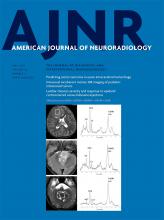Index by author
Heagerty, P.J.
- EDITOR'S CHOICESpineOpen AccessLumbar Spinal Stenosis Severity by CT or MRI Does Not Predict Response to Epidural Corticosteroid versus Lidocaine InjectionsF.A. Perez, S. Quinet, J.G. Jarvik, Q.T. Nguyen, E. Aghayev, D. Jitjai, W.D. Hwang, E.R. Jarvik, S.S. Nedeljkovic, A.L. Avins, J.M. Schwalb, F.E. Diehn, C.J. Standaert, D.R. Nerenz, T. Annaswamy, Z. Bauer, D. Haynor, P.J. Heagerty and J.L. FriedlyAmerican Journal of Neuroradiology May 2019, 40 (5) 908-915; DOI: https://doi.org/10.3174/ajnr.A6050
In this secondary analysis of the CT and MR imaging studies of the prospective, double-blind Lumbar Epidural Steroid Injections for Spinal Stenosis (LESS) trial participants, the authors found no differences in baseline imaging characteristics between those receiving epidural corticosteroid and lidocaine and those receiving lidocaine alone injections. No imaging measures of spinal stenosis were associated with a differential response to corticosteroids, indicating that imaging parameters of spinal stenosis did not predict a response to epidural corticosteroids.
Heo, Y.J.
- NeurointerventionYou have accessPointwise Encoding Time Reduction with Radial Acquisition with Subtraction-Based MRA during the Follow-Up of Stent-Assisted Coil Embolization of Anterior Circulation AneurysmsY.J. Heo, H.W. Jeong, J.W. Baek, S.T. Kim, Y.G. Jeong, J.Y. Lee and S.-C. JinAmerican Journal of Neuroradiology May 2019, 40 (5) 815-819; DOI: https://doi.org/10.3174/ajnr.A6035
Hernandez-perez, M.
- EDITOR'S CHOICEAdult BrainOpen AccessPredicting Motor Outcome in Acute Intracerebral HemorrhageJ. Puig, G. Blasco, M. Terceño, P. Daunis-i-Estadella, G. Schlaug, M. Hernandez-Perez, V. Cuba, G. Carbó, J. Serena, M. Essig, C.R. Figley, K. Nael, C. Leiva-Salinas, S. Pedraza and Y. SilvaAmerican Journal of Neuroradiology May 2019, 40 (5) 769-775; DOI: https://doi.org/10.3174/ajnr.A6038
The authors prospectively studied patients with motor deficits secondary to primary intracerebral hemorrhage within the first 12 hours of symptom onset. Patients underwent multimodal MR imaging including DTI. Intracerebral hemorrhage, perihematomal edema location and volume, and corticospinal tract involvement were assessed. The corticospinal tract was considered affected when the tractogram passed through the intracerebral hemorrhage and/or the perihematomal edema. The authors calculated affected corticospinal tract-to-unaffected corticospinal tract ratios for fractional anisotropy, mean diffusivity, and axial and radial diffusivities. Significant independent predictors of motor outcome were NIHSS and modified NIHSS at admission, posterior limb of the internal capsule involvement by intracerebral hemorrhage at admission, intracerebral hemorrhage volume at admission, 72-hour NIHSS, and 72-hour modified NIHSS. The sensitivity, specificity, and positive and negative predictive values for poor motor outcome at 3 months by a combined modified NIHSS of >6 and posterior limb of the internal capsule involvement in the first 12 hours from symptom onset were 84%, 79%, 65%, and 92%, respectively.
Herrera, D.A.
- PediatricsYou have accessNeuroimaging Findings in Moebius SequenceD.A. Herrera, N.O. Ruge, M.M. Florez, S.A. Vargas, M. Ochoa-Escudero and M. CastilloAmerican Journal of Neuroradiology May 2019, 40 (5) 862-865; DOI: https://doi.org/10.3174/ajnr.A6028
Hiramatsu, M.
- NeurointerventionOpen AccessVisualization of Aneurysmal Neck and Dome after Coiling with 3D Multifusion Imaging of Silent MRA and FSE-MR CisternographyT. Satoh, T. Hishikawa, M. Hiramatsu, K. Sugiu and I. DateAmerican Journal of Neuroradiology May 2019, 40 (5) 802-807; DOI: https://doi.org/10.3174/ajnr.A6026
Hishikawa, T.
- NeurointerventionOpen AccessVisualization of Aneurysmal Neck and Dome after Coiling with 3D Multifusion Imaging of Silent MRA and FSE-MR CisternographyT. Satoh, T. Hishikawa, M. Hiramatsu, K. Sugiu and I. DateAmerican Journal of Neuroradiology May 2019, 40 (5) 802-807; DOI: https://doi.org/10.3174/ajnr.A6026
Hiwatashi, A.
- FELLOWS' JOURNAL CLUBPediatricsOpen AccessIntravoxel Incoherent Motion MR Imaging of Pediatric Intracranial Tumors: Correlation with Histology and Diagnostic UtilityK. Kikuchi, A. Hiwatashi, O. Togao, K. Yamashita, R. Kamei, D. Momosaka, N. Hata, K. Iihara, S.O. Suzuki, T. Iwaki and H. HondaAmerican Journal of Neuroradiology May 2019, 40 (5) 878-884; DOI: https://doi.org/10.3174/ajnr.A6052
Between April 2013 and September 2015, seventeen children with intracranial tumors were included in this retrospective study. Intravoxel incoherent motion parameters were fitted using 13 b-values for a biexponential model. The perfusion-free diffusion coefficient, pseudodiffusion coefficient, and perfusion fraction were measured in high- and low-grade tumors. The authors found significant correlations between the histology and IVIM parameters of different pediatric intracranial tumors. These results suggest that IVIM imaging reflects cell density and vascularity across different types of pediatric brain tumors. They also demonstrated that both the diffusion and perfusion parameters measured on IVIM imaging are useful for grading intracranial neuroectodermal tumors in pediatric patients.
Honda, H.
- FELLOWS' JOURNAL CLUBPediatricsOpen AccessIntravoxel Incoherent Motion MR Imaging of Pediatric Intracranial Tumors: Correlation with Histology and Diagnostic UtilityK. Kikuchi, A. Hiwatashi, O. Togao, K. Yamashita, R. Kamei, D. Momosaka, N. Hata, K. Iihara, S.O. Suzuki, T. Iwaki and H. HondaAmerican Journal of Neuroradiology May 2019, 40 (5) 878-884; DOI: https://doi.org/10.3174/ajnr.A6052
Between April 2013 and September 2015, seventeen children with intracranial tumors were included in this retrospective study. Intravoxel incoherent motion parameters were fitted using 13 b-values for a biexponential model. The perfusion-free diffusion coefficient, pseudodiffusion coefficient, and perfusion fraction were measured in high- and low-grade tumors. The authors found significant correlations between the histology and IVIM parameters of different pediatric intracranial tumors. These results suggest that IVIM imaging reflects cell density and vascularity across different types of pediatric brain tumors. They also demonstrated that both the diffusion and perfusion parameters measured on IVIM imaging are useful for grading intracranial neuroectodermal tumors in pediatric patients.
Huang, Y.-C.
- SpineYou have accessAssessing Vascularity of Osseous Spinal Metastases with Dual-Energy CT-DSA: A Pilot Study Compared with Catheter AngiographyY.-C. Huang, F.-Y. Tsuang, C.-W. Lee, C.-Y. Wu and Y.-H. LinAmerican Journal of Neuroradiology May 2019, 40 (5) 920-925; DOI: https://doi.org/10.3174/ajnr.A6023
Huda, F.
- You have accessChimeric Antigen Receptor T-Cell Therapy: What the Neuroradiologist Needs to KnowH.A. Valand, F. Huda and R.K. TuAmerican Journal of Neuroradiology May 2019, 40 (5) 766-768; DOI: https://doi.org/10.3174/ajnr.A6042








